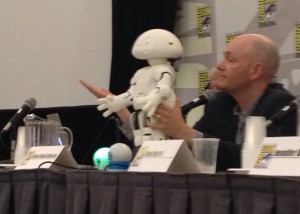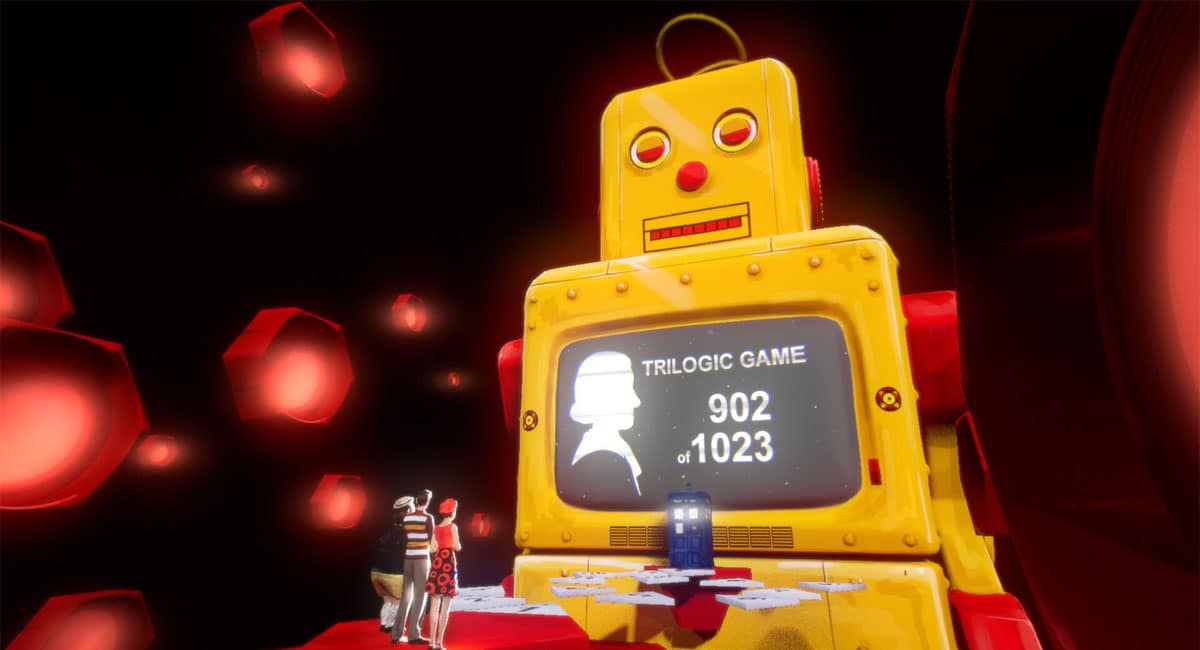By Matthew Jent
Introduced by Brent Spiner, who we all know best as The Next Generation’s Data, this Saturday morning panel was loaded with scientists, futurists, and engineers who looked to science-fiction to inform the work they did creating science fact.
Spiner kicked things off with an incongruous Matthew McConaughey impression that was just bad enough to be endearing. He quickly introduced the moderator and the panel, and was clearly having a good time addressing the filled-to-capacity room.
The panel was moderated by Tweet House and the Parnassus Group’s Steve Broback and included guests Brian David Johnson, resident futurist at Intel; Ross Ingram, community manager for Sphero; Jennifer Barry of Rethink Robotics and an engineer behind the Baxter robot; Jason Crusan, director of the Advanced Exploration Systems Division at NASA; and Marty Linn, principle engineer of robotics at General Motors.
The panel began with Brian showing off Jimmy the Robot, a 3D-printable, open source robot that can download apps that update and personalize him. Jimmy is designed to be as adaptable and social — if not moreso — than a smartphone. “We want as many people downloading, designing, and personalizing their own personal robot as possible,” Brian said.

Brian addressed “the Terminator in the room” by saying that robots aren’t likely to rise up and destroy humanity. Jimmy’s design was based on E.T. and an iMac — “cute and stompable.” Ross’s Sphero, another cute, if rounder, robot, is similarly built to be fun and social, with a pricepoint designed to be accessible.
Jennifer and Rethink Robotics’ Baxter is a more humanoid robot that is human trainable through mimicry. Jennifer and her team paid particular attention to Baxter’s eyes, designing it so that Baxter would look where it was going before it went there. Years ago, limited processing power meant robots like Baxter had to spend several minutes thinking about the best course of action before moving. But Moore’s Law — that processing power tends to double every two years — along with relatively inexpensive Series Elastic Actuators, allowed Baxter to move more quickly, be aware of its own limbs, and know whether it was coming into unexpected contact with nearby humans or objects.
Baxter is a very useful robot, but with a pretty steep pricepoint — around $25k. “You can sign up after the panel,” said. “We accept Square, so…”
Jason Crusan offered a quick rundown on NASA’s recent history using robots, from the Curiosity rover on Mars to the humanoid Robonaut that was built and employed on the International Space Station, to Sphere, robotic orbs that are already at work on the International Space Station and resemble larger versions of the training droids used by Luke Skywalker on the Millennium Falcon.
When Jason mentioned that the next generation of Sphere robots are currently unnamed, an audience member shouted out V’Ger! to scattered applause.
“And this,” Jason said, “is why NASA doesn’t do public voting polls.”
Marty Linn introduced himself by saying that General Motors was the first company in the world — and the galaxy — and the known universe — to employ robots.
“We’re very serious about robots,” he said. “You guys are talking about fun and fantasy, and you’re not serious about robots. It’s serious business. There’s no fantasy or magic involved at all.”
There were a few scattered boos in the crowd, but Marty then played a video from General Motors of their robots helping Santa’s elves to build, wrap, and deliver a Camaro.
Marty also showed off a special glove he wore, built with the servos and actuation system from the Robonaut 2. It allowed for enhanced grasp strength with servo motors attached at the forearm, powered by a battery pack clipped to Marty’s belt. Linear actuators manipulate the wearer’s tendons, adding about twenty pounds of force to his or her grasp.

“This could help astronauts, this could help all manner of people with disabilities,” Marty said.
Every panelist was enthusiastic about their own love of science-fiction, and the role it played in their desire to re-create some of the things they’d read about or seen on screens. Jennifer Barry’s first robot was named after Daneel, an android Asimov’s robot stories, and Jason Crusan looked to the Jetsons, Stargate, and Battlestar Galactica for inspiration with his work at NASA.
Sci-fi can become a self-fulfilling prophecy as fans become futurists become technicians and engineers, building the technology and tools of the future. We just have to be careful which fictions we bring to life.
As Brent Spiner asked from the audience, discussing Jimmy the Robot — “He doesn’t have an evil twin brother, does he?”








Great site. Great articles. Congratulations
Comments are closed.